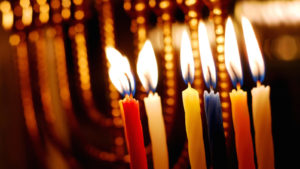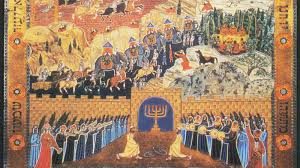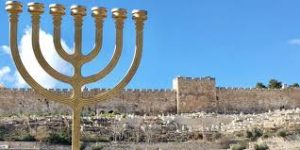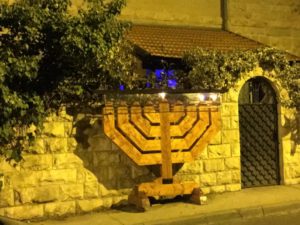8 New Things I Learned About Hanukkah
Every year I learn something new about the Jewish holidays, which are all rich in history and dramatic storytelling of survival that influence our treasured customs, traditions, rituals, and, of course, our favorite foods because c’mon we love to eat. Hanukkah, which falls in November or December when the dark days of winter are approaching, happens to be one of the most widely celebrated times in the Jewish calendar. It’s popularity is not because the Festival of Lights is the most sacred holiday but because religious and nonreligious Jews alike embrace the traditions of lighting the menorah, eating latkes, spinning the dreidel, exchanging gifts, and devouring those gold foiled candies known as chocolate gelt, a Yiddish word for “money.” But Hanukkah, which is a Hebrew word for “dedication,†means so much more than enjoying fun and games and splurging on scrumptious sufganiyot or jelly-filled doughnuts.
As early as preschool, we are taught about the Hanukkah miracles of the Maccabees and the oil lasting for eight days, and as we grow up and mature and become parents ourselves, we continue to find deeper meaning of the sacrifices that our ancestors made thousands of years ago and how these lessons are relevant to our modern lives. By celebrating these holidays, sharing the joy with our children, and growing spiritually from each other, we continue to learn, show our pride, and most importantly keep Judaism alive.
So, following are EIGHT fascinating facts that I discovered or re-learned in a new way about Hanukkah this year. Feel free to share your new insights of Hanukkah, too!
ONE. First, I need a refresher course on the magnitude of the first miracle of Hanukkah that is somehow overlooked by the oil lasting for eight days. And that miracle is how a handful of men, who mainly consisted of their leader Judah and his five brothers known as the Maccabees, beat the odds and defeated over a series of battles the entire Syrian army to save their Jewish people. By the way, the name Maccabees is taken from the Hebrew word “hammer,†which describes the guerilla warfare tactics that the Jews used against the ancient Greeks.
Judah, the son of Mattathias, led this ragtag group of simple farmers who were dedicated to the laws of Moses and equipped only with spears, bows and arrows, and rocks from the terrain. This small band of rebels lived in the mountains and hills and knew the land well, thereby knowing how to outsmart the enemy by plotting surprise attacks in the middle of the night. Think about it, the Maccabees had no sophisticated weapons or military training, some of them were probably Rabbis, and yet this small band of men mightily fought 40,000 foot soldiers and a powerful cavalry of well-armed troops whose goal was to crush the small rebellion and strip them of their Jewish identity. Antiochus and his relentless invaders were not sought out to kill the Jews as much as they were to strip them of their Jewish pride by forcing them to worship their Greek idols and gods. The Greek ruler outlawed any Jewish observance, including Shabbat and Torah study ― under penalty of death. What the Maccabees were able to accomplish over a three year period is comparable on the scale of Israel defeating the combined super-powers of today. A miracle, indeed.
After the Maccabean victory, the Jewish fighters made their way to the Temple Mount where they found their sacred land in shambles and desecrated with idols. The Maccabees cleansed the Temple and re-dedicated it on the 25th of Kislev. When it came time to re-light the Menorah, they searched the entire Temple, but found only one jar of pure oil. The group of believers lit the Menorah anyway and were rewarded with the second miracle in the Hanukkah story: That small flask of olive oil kept the candles burning for a full eight days and nights until they could make more.
From then on, Jews have observed Hanukkah for eight days, in honor of this historic victory and the miracle of the oil.
TWO. Now that we understand the basics of the story, here’s a new twist, at least for me. Women played a key role in the military victory over the Syrio-Greeks. This is why we are not only legally obligated to light Hanukkah candles, we are also supposed to refrain from work for 30 minuites while the flames burn on the menorah branch. Yes, that’s right, it’s a mitzvah for women and girls to relax and bask in the warm glow of the lights and leave the mess in the kitchen to honor the brave women in the Hanukkah story. Legend tells about how Judith, who was a young widow living at the time of the Maccabees in a town called Bethulia, used her womanly ways to prevent the impending siege of Jerusalem by entering the army camp and seducing Assyrian general Holofernes. As the story goes, Judith fed him a lavish feast with salty cheese (hence we eat cheese latkes), which made him thirsty so he would drink lots of wine and pass out. She then chopped off his head, brought his bloody body part to the gates to frighten and ward off the troops so they fled the Maccabees. Today, women light the Hanukkah candles to honor Judith’s heroic action and courage.
THREE. The first Jewish menorah was the one with seven branches that was lit by Kohanim (priests) at the Holy Temple during Biblical times in Jerusalem. It is the symbol of the Jewish people and the State of Israel. The nine branch menorah, called in Hebrew “Chanukiyyah,” is used only during the holiday of Hanukkah. It was created to commemorate the victory of the Jewish Maccabees over the Greco-Syrians in 165 B.C.E. and the miraculous burning of a one-day supply of oil in the seven branch menorah for eight days. On the Hanukkah menorah, eight of the arms are for the candles which represent the eight miracle days, and the ninth arm is called the shamash, which means “use†or “serving†and this special candle is used to kindle the other candles.
FOUR. There are three commandments in the Torah to light up– Shabbat candles, havdalah candle, and Hanukkah. Shabbat candles represent shalom bayit, peace in the home. These candles are lit indoors and represent Judaism’s inner light, the light that makes our home holy.  The havdalah candle, which is made up of several wicks woven together, represents the fusion of the two, the inner light of Shabbat, joined to the outer light we make during the six days of the week when we go out into the world and live our faith in public.
FIVE. The Hanukkah candles originally were used to be lit outside the front door. However, because of fear of persecution, Jewish people brought their Hanukkah candles back inside their homes. In recent times, Rabbis introduced the custom of lighting giant menorahs in public places to bring back the original spirit of the day. “We are a light unto the nation†and “Let there be light†are evident as Hanukkah candles bring the light of Judaism to the world. Even with antisemitism still in existence, the public display of Hanukkah lights symbolize our freedom and that we are proud to be who we are.
Every Friday night on Shabbat and for all eight nights of Hanukkah, the light of the candles enlighten our lives and others by shedding light in darkness and reminding us of what is really important in life, not so much the materialistic things we strive for but spiritual understanding and relationships that brings us happiness.
SIX. Â A menorah can be made out of anything, unlike Shabbos candles which are typically ornate and displayed higher up to symbolize their elevated purpose. During the Holocaust, observance of Shabbat and Jewish festivals was severely restricted. Â Jews were forbidden to practice their religion, or they faced punishment and even death.
In the book “Hassidic Tales of the Holocaust,†author Yaffa Eliach shares an anecdote about celebrating Hanukkah in the Bergen-Belsen camp:
“A seemingly impossible celebration came about on the first night of Hanukkah 1943 in Bergen-Belsen. One of 11 fortunate survivors, Rabbi Israel Shapiro, better known as the Bluzhever Rebbe, was the central figure of that macabre Hanukkah celebration. Living in the shadow of death, and not knowing when their own turn would come, the Jewish inmates were determined to celebrate Hanukkah in the traditional manner and draw whatever spiritual strength they could from the story of the Maccabees.
“From their meager food portions, the men saved up some bits of fat. The women, for their part, pulled threads from their tattered garments and twisted them into a makeshift wick. For want of a real menorah, a candle-holder was fashioned out of raw potato. Even dreidels for the children in the camp were carved out of the wooden shoes that inmates wore…â€
There are many stories documented of how Jewish prisoners risked their lives to keep their religious observances alive. Today, we are free to celebrate our heritage any way we want, so we must not take this freedom for granted. Especially in times of darkness, whether it be our personal lives or as a nation, we can always find a flicker of light and hope.
SEVEN. In times of persecution when Torah study was forbidden, Jewish children would learn anyway. When soldiers would investigate, the children would pull out a dreidel and pretend to be playing.
The letters on the dreidel are nun, gimmel, hey, shin ― the first letters of Nes Gadol Haya Sham – “A Great Miracle Happened There.” (In Israel, the last letter is a Pey ― “Here.”) One way to play dreidel is to see who can keep theirs spinning for the longest time. Another fun way to compete is to see how many dreidels you can spin simultaneously.
Here’s a reminder of the basic rules of dreidel. Players use pennies, nuts, raisins, or chocolate coins as tokens or chips. Each person puts an equal share into the “pot.” The first player takes a turn spinning the dreidel. When the dreidel stops, the letter facing up determines:
- Nun – nothing happens; the next player spins the dreidel
- Gimmel – the spinner takes the pot
- Hey – take half the pot
- Shin – add one to the pot
EIGHT. To best publicize the Hanukkah miracle, the menorah is ideally lit outside the doorway of your house, on the left side when entering. (The mezuzah is on the right side; in this way you are “surrounded by mitzvot.”) In Israel, many people light outside in special glass boxes built for a menorah. Also in Israel, some Jewish families display their menorah close to the ground, yet high enough for passersby to see, which symbolizes that where there is darkness during the low periods in our lives, we need to search for the light to reveal insight that seems hidden.
If this is not practical, the menorah should be lit in a window facing the public thoroughfare. This shows our Jewish pride, our light unto the world. The candle can be fused by wax or oil, and on the first night, one candle is set to the far right of the menorah. On the following night, a second candle is inserted to the left of the first one, and then add one light each night of Hanukkah, moving from right to left.
If for some reason the menorah cannot be lit by a window, it may be lit inside the house on a table; this at least fulfills the mitzvah of “publicizing the miracle” for family and friends to enjoy and remember what Hanukkah is all about.
Happy Hanukkah, Chag Sameach, may the glow of the lights burn warm in bright in your home and in your heart this holiday!





